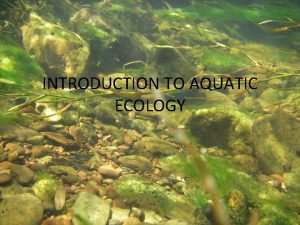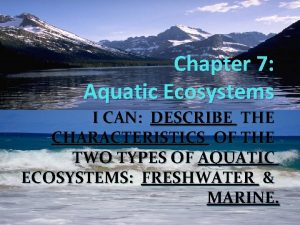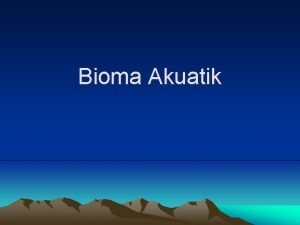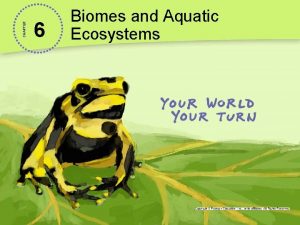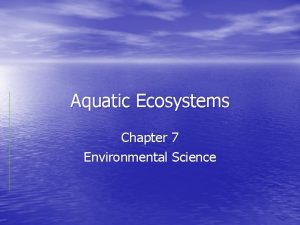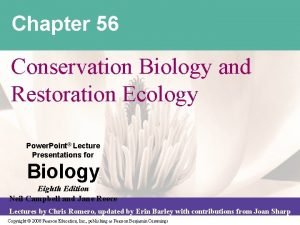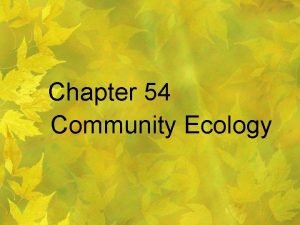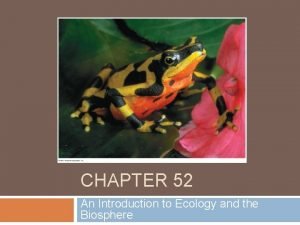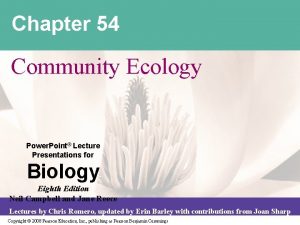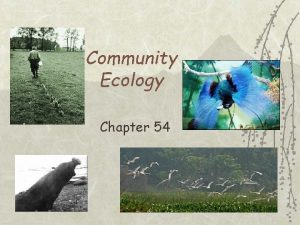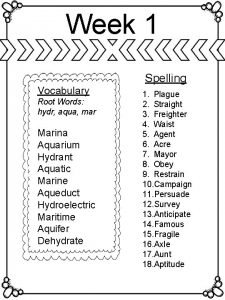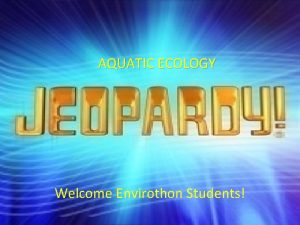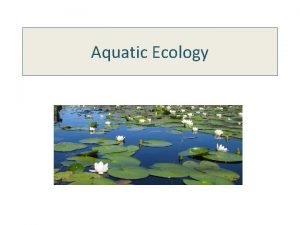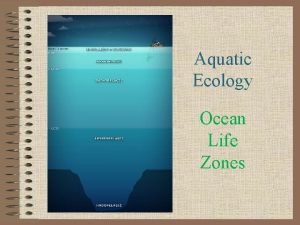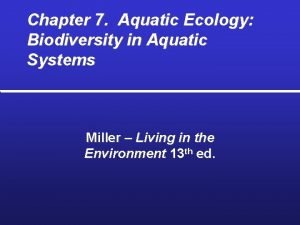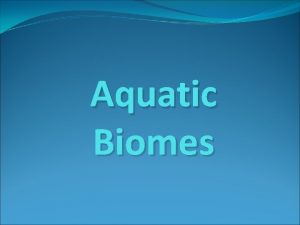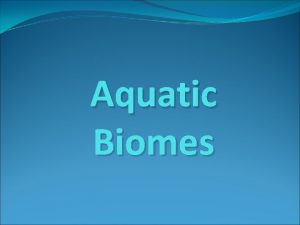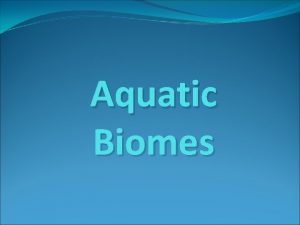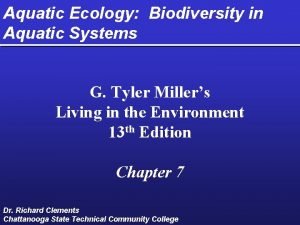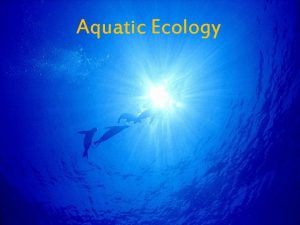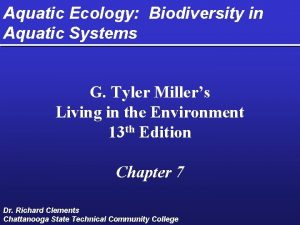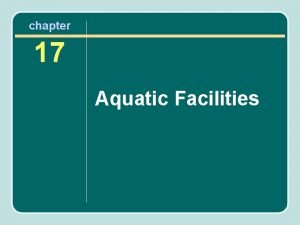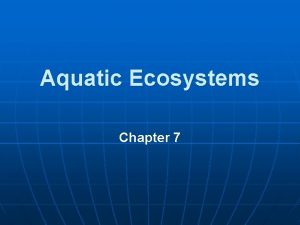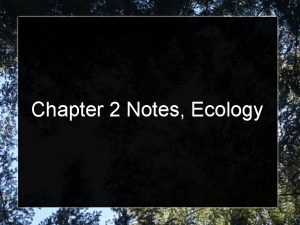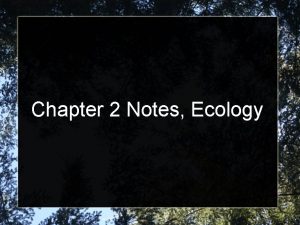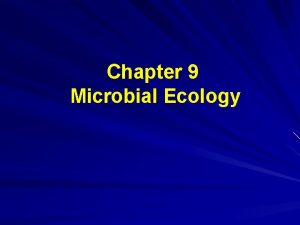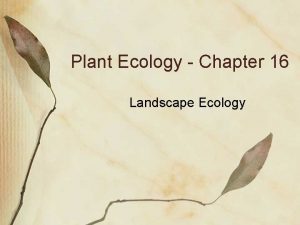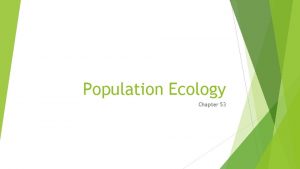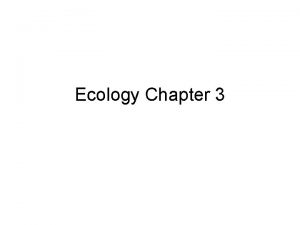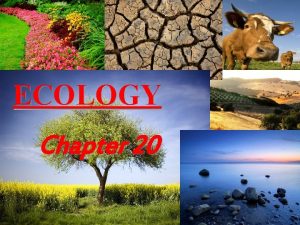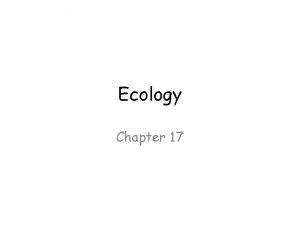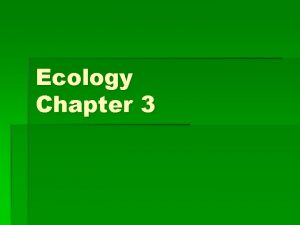Aquatic Ecology Chapter 7 Types of aquatic life

































- Slides: 33

Aquatic Ecology Chapter 7

Types of aquatic life zones: Ø Saltwater or marine l Ø Estuaries, coastlines, coral reefs, coastal marshes, mangrove swamps, and oceans Freshwater l Lakes and ponds, streams and rivers, and inland wetlands

Major types of organisms Ø Phytoplankton – plant plankton l Free-floating microscopic cyanobacteria and algae • The producers and the basis of the food chain Ø Zooplankton – animal plankton l l Nonphotosynthetic herbivores that feed on phytoplankton Secondary consumers that feed on other zooplankton • Range from single-celled protozoa to large invertebrates such as jellyfish.

Ø Nekton l Ø Benthos l l Ø Fish, turtles, and whales Bottom-dwellers – barnacles & oysters that anchor to one spot Worms – burrow into sand or mud Lobsters and crabs – walk on the bottom Some are filter-feeders Decomposers l Bacteria that break down organic compounds

Key Characteristics of aquatic organisms Ø Less pronounced and fixed physical boundaries; therefore difficult to count and manage populations Ø More complex and longer food chains Ø More difficult to monitor and study because of their size and they are hidden from view.

Limiting Factors Ø Aquatic life zones are divided into three layers – surface, middle, and bottom Ø Factors are: l l Temperature Access to sunlight for photosynthesis Dissolved oxygen (DO) content Availability of nutrients such as carbon (CO 2), nitrogen (NO 3), and phosphorus (PO 4) for producers

Photosynthesis can take place only as deep as light can penetrate (euphotic zone) Ø Oxygen gets in from photosynthesis and diffusion for air and is removed by aerobic respiration (includes decomposition) Ø l l l O 2 can vary greatly in aquatic ecosystems Most aquatic organisms cannot survive below 5 ppm of DO DO and CO 2 concentrations vary with depth

Why are oceans important? Ø Cover 71% of earth’s surface Ø Contain about 250, 000 known species Ø Provide many ecological and economic services Ø Less that 5% has been explored and mapped

Coastal zone Warm, nutrientrich, shallow water that extends from the high tide mark to the margin of the continental shelf Ø makes up less than 10% of ocean but contains 90% of all marine species and is especially important to commercial fisheries. Ø Gets: Ø l Sunlight and nutrients

Ø Estuaries – a partially enclosed area where seawater mixes with fresh water l Ø Coastal Wetlands – covered by water all or part of the year l Ø river mouths, inlets, bays, sounds, mangrove swamps, and salt marshes Temperature and salinity vary widely l Ø An ecotone Tides, seasonal variation in water flow, unpredictable flows after heavy rains and floods VERY PRODUCTIVE AREAS!

Intertidal zone – area of shoreline between high and low tides Ø Very stressful zone for organisms: Ø l l Wave stress Immersed during high tides and dry during low tides Changing levels of salinity Organisms usually cling to something, dig or hide in shells.

Ø Barrier Islands l l l Long, thin, low offshore islands of sedement that generally run parallel to shore Help protect mainland Constantly shift

Coral reefs Form in clear, warm, coastal waters in tropics and subtropics Ø Have many types of organisms Ø l l l Attached – corals, algae, and sponges Fishes Small organisms that bore into or attach themselves to coral Easily damaged, grow slowly, can survive only in clear, shallow, warm water Ø Have been harmed by global warming Ø They face many threats from pollution and other human activities. Ø

Open Sea Beyond the continental shelf Ø Euphotic zone: lighted upper area Ø l l l Ø Bathyl zone: dimly lit middle zone l Ø Photosynthesis Low nutrient levels High DO No photosynthesis Abyssal zone: dark lower zone l l l Very cold Little DO Many nutrients

Some open sea organisms Ø Deposit feeders l Ø Filter feeders l Ø Take mud into their bodies and extract nutrients from it Pass water through or over their bodies and extract nutrients from it Average primary productivity & NPP are low.

Human Impact Ø Losing coastal areas to development l Housing, marinas, golf courses Ø Filling in for agriculture Ø Much beach erosion due to development and rising sea levels Ø Dredging and heavy nets used in trawling is destroying bottom habitats Ø Coral reefs are being severely damaged

Freshwater life zones Ø Found where water with a dissolved salt concentration of less than 1% by volume either accumulates or flows through the surfaces of terrestrial biomes. l l Standing water – lakes, ponds, inland wetlands Flowing water – streams and rivers Covers less than 1% of the earth’s surface but ecologically and economically important Ø Are very closely connected to terrestrial biomes due to nutrient run-off Ø

Life zones Ponds – shallow – light often penetrates to the bottom – usually have only one zone Ø Lakes – deeper – generally consist of four zones – defined by depth and distance from shore Ø l l Littoral zone – shallow water near shore where rooted plants grow Limnetic zone – open sunlit water away from shore – as deep as sunlight penetrates Profundal zone – deep open water that receives no sunlight – cool so although oxygen is low, some fish live here. Benthic zone – bottom of lake – cool temperatures and low oxygen

© 2004 Brooks/Cole – Thomson Learning Freshwater Systems Ecological Services Economic Services • Climate moderation • Food • Nutrient cycling • Drinking water • Waste treatment and dilution • Irrigation water • Hydroelectricity • Flood control • Groundwater recharge • Transportation corridors • Recreation • Habitats for aquatic and terrestrial species • Genetic resources and biodiversity • Scientific information • Employment

Eutrophication – the natural ageing of a lake Classify lakes according to nutrient content and primary productivity Ø OLIGOTROPHIC LAKE – low nutrients Ø l l l l Geographically young Deep Blue in color Colder Low populations of phytoplankton More desirable fish – bass and trout Low NPP

Ø EUTROPHIC LAKE – many nutrients Ø Old lake Ø Shallow Ø Green or brown in color (algae) Ø Warmer Ø Algal blooms are common Ø Less desirable types of fish – catfish, carp Ø High NPP

Sunlight Narrow littoral zone Little shore vegetation Low concentration of nutrients and plankton Sparse fish population Limnetic zone Profundal zone Sleepily sloping shorelines Sand, gravel, rock bottom Oligotrophic lake Sunlight Wide littoral zone Much shore vegetation High concentration of nutrients and plankton Limnetic zone Profundal zone Eutrophic lake Dense fish population Gently sloping shorelines Silt, sand, clay bottom Figur

Cultural Eutrophication Ø Humans add nutrients from the atmosphere, urban, and agricultural areas accelerate eutrophication.

SEASONAL CHANGES IN LAKES Ø Occurs in temperate lake Ø Makes use of the property of water that it is less dense as a solid (0 o. C) then it is at a liquid (4 o. C); therefore ice floats on water. Ø This causes THERMAL STRATIFICATION of deep lakes

Summer Ø Ø Ø Lakes have three distinct layers: EPILIMNION – upper layer of warm water high levels of DO THERMOCLINE – layer where the temperature changes with depth – usually 1 o. C/meter increase in depth – moderate oxygen – during summer acts as a barrier between epilimnion and hypolimnion HYPOLIMNION – bottom layer of cold, dense water – low DO To keep cool fish would be at the bottom but low DO there

Fall Overturn Ø Water begans to cool, becomes more dense and sinks to the bottom Ø The thermocline disappears Ø Water mixes – nutrients are carried to the top and oxygen to the bottom. Fish can be found at all depths

Winter Ø Lake separates into layers again due to difference in density. Ø Warmest (4 o. C)water is at the bottom Ø Thermocline is reversed Ø Coldest water is at the top and freezes forming ice which insulates and protects the lake.

Spring overturn Ø Water begins to warm up Ø Wind blows causing vertical currents Ø Lake overturns again bring nutrients to the top and oxygen to the bottom


Characteristics of Freshwater Ø Surface water forms when precipitation that does not sink into the ground or evaporate becomes run-off Ø Watershed – the land area that delivers run-off, sediment, and dissolved substances to a stream. Ø Streams join together to form rivers Ø Rivers flow downhill to the ocean

Ø Inland wetlands – land covered with water all or part of the year located away from the ocean l l l Marshes – have a few trees Swamps –dominated by trees and shrubs Prairie potholes – depressions formed by glaciers Floodplains – receive water during heavy rains or floods Bogs and fens – waterlogged peaty areas


Human impact Ø 60% of the world’s largest rivers are fragmented by dams – destroys wildlife and reduces water flow Ø Flood control levees and dikes – destroy habitats, disconnect rivers from floodplains, and eliminate wetlands Ø In U. S. 53% of the wetlands have been drained or filled to grow crops – this has increased flooding
 Aquatic ecology definition
Aquatic ecology definition Chapter test a chapter 4 population ecology answer key
Chapter test a chapter 4 population ecology answer key Aquatic ecosystems webquest
Aquatic ecosystems webquest Zonation in aquatic biomes
Zonation in aquatic biomes Aquatic areas
Aquatic areas Chapter 6 biomes and aquatic ecosystems
Chapter 6 biomes and aquatic ecosystems Chapter 6 biomes and aquatic ecosystems
Chapter 6 biomes and aquatic ecosystems Chapter 3 lesson 3 biomes and aquatic ecosystems
Chapter 3 lesson 3 biomes and aquatic ecosystems Chapter 7 environmental science
Chapter 7 environmental science Chapter 7 aquatic ecosystems test answers
Chapter 7 aquatic ecosystems test answers Chapter 52: an introduction to ecology and the biosphere
Chapter 52: an introduction to ecology and the biosphere Chapter 3 section 1: community ecology
Chapter 3 section 1: community ecology Chapter 56 conservation biology and restoration ecology
Chapter 56 conservation biology and restoration ecology Phosphorus cycle pearson education
Phosphorus cycle pearson education Chapter 54 community ecology
Chapter 54 community ecology Chapter 53 population ecology
Chapter 53 population ecology Chaparral climograph
Chaparral climograph 5 evolution and community ecology
5 evolution and community ecology Equilibrial life history
Equilibrial life history Principles of ecology chapter 2
Principles of ecology chapter 2 Principles of ecology section 2.1 worksheet answers
Principles of ecology section 2.1 worksheet answers Chapter 2 section 1 organisms and their relationships
Chapter 2 section 1 organisms and their relationships Ecology
Ecology Chapter 54 community ecology
Chapter 54 community ecology Chapter 53 population ecology
Chapter 53 population ecology Chapter 55 ecosystems and restoration ecology
Chapter 55 ecosystems and restoration ecology Chapter 5 evolution and community ecology
Chapter 5 evolution and community ecology Chapter 5 evolution and community ecology answer key
Chapter 5 evolution and community ecology answer key Population ecology chapter 4 answers
Population ecology chapter 4 answers Principles of ecology chapter 2 section 1 answer key
Principles of ecology chapter 2 section 1 answer key Chapter 4 section 1 population dynamics answer key
Chapter 4 section 1 population dynamics answer key Chapter 53 population ecology
Chapter 53 population ecology Chapter 54 community ecology
Chapter 54 community ecology Aqua spelling
Aqua spelling
